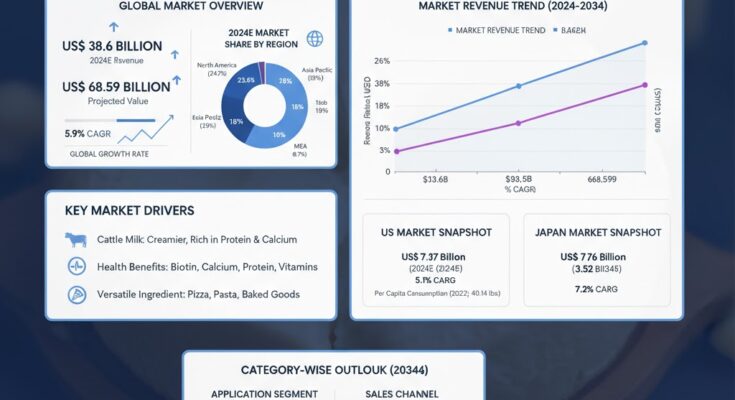The global mozzarella cheese market is set for substantial growth over the next decade, driven by the rising consumption of dairy-based products, increasing demand for ready-to-eat and convenience foods, and the expanding use of cheese in quick-service restaurants and food processing applications. According to a recent report by Fact.MR, the market is estimated at US$ 38.6 billion in 2024 and is projected to rise at a CAGR of 5.9%, reaching US$ 68.59 billion by 2034.
As global consumers prioritize high-protein diets and indulgent flavors, mozzarella cheese has become a key ingredient across foodservice, retail, and industrial applications. The growing popularity of Western-style cuisines, such as pizza and pasta, particularly in emerging economies, is fueling sustained demand.
Strategic Market Drivers
Rising Consumption of Processed and Functional Dairy Products
Health-conscious consumers are increasingly opting for dairy-based proteins and nutrient-rich cheese varieties. Mozzarella cheese, being a rich source of calcium and protein with lower sodium content compared to other cheeses, is witnessing higher demand in both developed and developing markets.
Growth in Quick-Service Restaurants (QSRs) and Food Processing
The global QSR boom—especially in pizza chains, sandwiches, and snack segments—is significantly driving mozzarella cheese usage. Food manufacturers are introducing pre-shredded, low-fat, and specialty mozzarella variants to cater to industrial and institutional buyers.
Innovation in Cheese Production and Packaging
Producers are adopting cutting-edge processing technologies such as ultrafiltration and enzyme-based coagulation to enhance shelf life, meltability, and texture. Moreover, creative and convenient packaging formats, including resealable pouches and portioned packs, are gaining traction among on-the-go consumers.
Rising Popularity in Emerging Markets
Urbanization, growing disposable incomes, and exposure to Western culinary trends are expanding cheese consumption in Asia-Pacific, the Middle East, and Latin America. Retail expansion and increased cold-chain logistics in these regions are also improving product accessibility.
Regional Growth Highlights
North America: The Largest Consumer Market
North America continues to dominate the mozzarella cheese market due to the strong presence of established dairy brands, high cheese consumption rates, and innovation in snacking formats. The U.S. remains a global leader, accounting for a significant portion of mozzarella used in the foodservice industry.
Europe: Home to Traditional Cheese Expertise
Europe’s robust dairy industry and long-standing cheese-making heritage ensure steady demand. Italy, the birthplace of mozzarella, leads production and export, while France and Germany are witnessing increased industrial use in frozen and processed foods.
East Asia: Rapid Growth and Urban Demand
East Asia is emerging as a fast-growing region for mozzarella cheese consumption. China, Japan, and South Korea are experiencing a surge in Western-style dining and domestic pizza chain expansions, boosting the need for high-quality mozzarella.
Emerging Economies: Expanding Dairy Infrastructure
In markets like India, Brazil, and GCC countries, increasing consumer exposure to international cuisines and improved cold storage facilities are driving imports and local production of mozzarella cheese.
Market Segmentation Insights
- By Source:
- Cow milk remains the dominant source, while buffalo milk mozzarella (especially “mozzarella di bufala”) is gaining premium appeal in gourmet segments.
- By Form:
- The shredded and block forms dominate industrial and foodservice use, whereas sliced and diced variants cater to retail consumers.
- By End Use:
- Foodservice applications account for the majority share, followed by food processing and household consumption.
Challenges and Market Considerations
Despite robust demand, several challenges affect the mozzarella cheese market’s growth:
- Fluctuating Milk Prices: Volatile raw milk costs can impact overall production margins and retail prices.
- Cold Chain and Storage Needs: Maintaining freshness and preventing spoilage require advanced refrigeration and logistics systems.
- Competition from Vegan Alternatives: The growing trend of plant-based cheese poses a challenge to traditional dairy producers, pushing them toward innovation in hybrid or lactose-free variants.
Competitive Landscape
The mozzarella cheese market is highly competitive, with major dairy players focusing on capacity expansion, product innovation, and branding to strengthen their market presence. Key players include Groupe Lactalis, Fonterra, and Grande Cheese Company, among others.
Key strategic initiatives include:
- Product Innovation:
In August 2022, Saputo Cheese USA Inc., part of Saputo Inc., launched “Frigo Cheese Heads Swirls”, an on-the-go snacking item combining mozzarella and cheddar cheese twists. The launch catered to consumers seeking convenient, nutritious snack options. - New Product Formats for Foodservice:
In March 2021, Dalter Alimentari Spa introduced a new cheese format — cheese matchsticks, designed for use in ready meals, salads, soups, and sauces. This innovative cut enhanced efficiency and convenience for the food manufacturing and service industries.
Leading companies are also employing eye-catching packaging designs, creative marketing campaigns, and integrated supply chain models to ensure product consistency and reliability. The consolidation of dairy operations—spanning milk collection, processing, and distribution—is helping firms achieve operational efficiency and maintain high product quality standards.
Outlook: A Decade of Creamy Growth Ahead
As global appetites for premium dairy products continue to rise, mozzarella cheese is set to maintain its dominance across culinary and industrial sectors. Continuous innovation in texture, formulation, and functionality—coupled with the global expansion of foodservice networks—will propel the market toward US$ 68.59 billion by 2034, positioning mozzarella as the cornerstone of the world’s evolving dairy industry.



